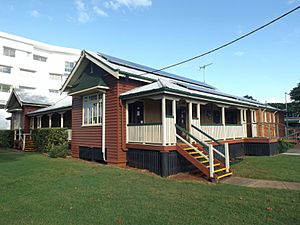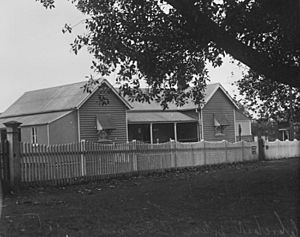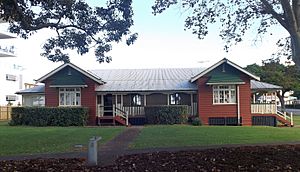Old Cleveland Police Station facts for kids
Quick facts for kids Old Cleveland Police Station |
|
|---|---|

Building in 2015
|
|
| Location | 1 Passage Street, Cleveland, City of Redland, Queensland, Australia |
| Design period | 1919 - 1930s (interwar period) |
| Built | 1934 - 1935 |
| Official name: Cleveland Police Station and Court House (former) | |
| Type | state heritage (built) |
| Designated | 26 March 1999 |
| Reference no. | 601933 |
| Significant period | 1930s (historical) 1930s (fabric) 1935–1998 (social) |
| Significant components | residential accommodation - police sergeant's house/quarters, courthouse, decorative features, police station, watch house |
| Lua error in Module:Location_map at line 420: attempt to index field 'wikibase' (a nil value). | |
The Old Cleveland Police Station is a special historic building located at 1 Passage Street in Cleveland, Queensland, Australia. It was built between 1934 and 1935. This old police station is now listed on the Queensland Heritage Register, which means it's protected because of its important history.
Contents
A Look Back: The Old Police Station's Story
The Old Cleveland Police Station and Courthouse was built from 1934 to 1935. You can find it at the corner of Passage and North Streets. This building was actually the second police station and courthouse built on this exact spot. It replaced an older building from 1879 that also served both purposes.
Cleveland's Early Days
In 1850, the area where Cleveland is now was surveyed for a town. The first land sales happened in 1851. Back then, there was a big competition between Cleveland and Brisbane. Both towns wanted to become the main port for the northern part of the Colony of New South Wales. Ipswich also hoped to be the capital of Queensland.
After Queensland became a separate colony in 1859, Cleveland got its first police station. It was in a rented building on Paxton Street. This building is still around today and is known as the Old Courthouse Restaurant. By the mid-1860s, over 100 people lived in Cleveland. This meant the town needed more government services. The Cleveland Police District was set up by 1865, with a sergeant and a constable.
Building the First Station
By the mid-1870s, the rented police building was getting old. Everyone agreed a new one was needed. Plans for a new police station and courthouse were drawn up in 1875. But the building wasn't constructed right away. In 1879, the Police Commissioner said the old station was in bad shape.
Work finally started by the end of 1879 and finished in 1880. It cost about £436. The new courthouse was built on a different piece of land than first planned. This new land, at the corner of Shore and Passage Streets, was officially set aside in 1884.
A Growing Town and New Needs
Once the police station and courthouse were built, a government area started to form. When the Cleveland railway line was built in the late 1880s, it ended right across from the police station. This was where the first Cleveland Central railway station was located. By the early 1900s, Cleveland's population had grown to over 500 people.
The first purpose-built police station and courthouse served the community for over 50 years. But by the early 1930s, it was showing its age. People started asking for a new building.
The New Building: Our Current Station
In November 1934, plans for a new police station and courthouse were made by William James Ewart. The new building cost almost £1500. It was described as a timber building with a corrugated fibrolite roof. It had a courtroom, an office, and a home for the police sergeant. The home included three bedrooms, a living room, kitchen, and verandas. An outdoor washhouse was also built. Some parts from the old building, like the cell block and stables, were reused.
The original plans from 1934 show a single-story timber building. It had a public waiting area, a courtroom, and an office. It also had open verandas on three sides and an enclosed veranda on the south side. This design was common for courthouses in country Queensland and suburban areas. The Cleveland Courthouse was designed to fit the town's needs and stand out as an important public building.
The building was designed with clear "public" and "private" areas. The public side faced the corner of Passage and North Streets. This gave more privacy to the living areas. The veranda on the eastern side was originally open. But it was enclosed by 1939 because of the weather. Over the years, more changes and additions have been made.
In 1963, there were plans to make the building bigger and add a new cell block. Older outbuildings were changed or removed to make space. By 1968, a new courthouse was planned closer to Middle Street. During these changes, the timber steps on the eastern side were replaced with concrete ones.
More work happened in 1973. Toilets were added inside the home, and a brick cell block was built to replace the old wooden cells. In the 1970s, extra portable buildings were added to the police area. By 1982, the main building was changed again to fit the CIB (Criminal Investigation Branch).
By 1998, the building had housed almost 50 staff members at different times. New police premises were built, and staff moved out in December 1998.
A New Purpose: Museum and Memorial
In 2000, the Redland Shire Council and the Returned Services League of Australia decided to turn the building into a war memorial museum. The new library and museum complex officially opened on July 28, 2007.
What the Old Station Looks Like
The former Cleveland Police Station and Courthouse is a single-story timber building. It sits low to the ground and looks out over the memorial park at the corner of North and Passage Streets. It has an H-shaped design with two gabled wings connected by a central verandahed section. The building is covered with weatherboards on the outside. Inside, and on the verandas, it has tongue and groove timber boarding. The front and side verandas have curved timber decorations and battened railings.
The station residence (the living area) is surrounded by verandas. You enter from the veranda facing North Street. The front door opens into a hall that leads to the dining veranda at the back. One wing has two bedrooms and a kitchen, all opening onto a sleepout veranda. The kitchen also connects to the enclosed dining veranda. The central wing holds the living room and another bedroom, both with verandas on the front and back. French doors open from the bedrooms and living room to the verandas.
The west wing has been changed a lot over time. The old entrances to the courthouse and office were from the west veranda. This veranda is now enclosed and divided into offices and storage. Concrete paths from 1935 show where the original timber stairs were. The courtroom is now split into two offices. Part of the glass wall that separated the courtroom and office can still be seen.
Behind the east wing, there's a small, separate timber washhouse. It has a concrete floor and a corrugated iron roof. Inside, you can see the timber frame, some shelves, and an old copper boiler.
There are also two newer additions to the south of the west wing. One is a brick and timber extension connected to the old office. Another is a steel-framed portable building further south. Other outbuildings on the site include a brick lock-up (jail cells) and garages. These newer structures are not considered part of the original historic value.
Why It's Important: Heritage Listing
The Old Cleveland Police Station and Courthouse was added to the Queensland Heritage Register on March 26, 1999. This means it's recognized as important for several reasons:
- Showing Queensland's History: This building helps us understand how Cleveland grew. It shows that Cleveland was once a very important center and port, even competing with Brisbane in its early days. The site has been used for law and order for nearly 120 years, starting with the first police station in 1879.
- A Rare Example: This building is special because it combined a courthouse, police station, and a home all in one. Most suburban police stations didn't have a courthouse attached. This shows how important Cleveland was as a major town outside of Brisbane.
- Great Design: The former Cleveland Police Station and Courthouse is a good example of a timber suburban courthouse. It shows the excellent work of the Government Architect's Office. They designed buildings that were practical, suited to the climate, and looked good, even on a modest scale.
- Beautiful and Important Location: The way the building is placed at the corner of Passage and North Streets highlights the area's early role as an important civic center. This area also includes a park, old trees, and a war memorial. The building itself has a strong, confident look that adds to the street. It was well-planned and suited its purpose.
- Strong Community Connection: The site of the former Cleveland police station and courthouse has a long history with law and order in Cleveland since 1879. It was a central point for many community services. Police officers living there also made it an important community hub.
- Connected to Important People: The building is also important because of its connection to Brisbane architect William James Ewart. He designed the building. Ewart was a chief architect for the Department of Public Works from 1923 to 1927 and a senior architect from 1927 to 1934.




